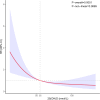Combined 25-hydroxyvitamin D concentrations and physical activity on mortality in US stroke survivors: findings from the NHANES
- PMID: 39806402
- PMCID: PMC11731136
- DOI: 10.1186/s12937-025-01076-x
Combined 25-hydroxyvitamin D concentrations and physical activity on mortality in US stroke survivors: findings from the NHANES
Abstract
Background: 25-hydroxyvitamin D [25(OH)D] concentrations and physical activity (PA) are linked and both are associated with changes in mortality. We examined the association of 25(OH)D and PA with all-cause or cause-specific mortality risk in stroke survivors.
Methods: The analysis included 677 stroke survivors from National Health and Nutrition Examination Survey (NHANES) 2007-2008 to 2017-2018. Independent and joint associations of 25(OH)D, PA and mortality among stroke survivors were analyzed using weighted Cox regression.
Results: We identified 133 all-cause deaths [major adverse cardiovascular events (MACE), 34; non-MACE, 79] with a median follow-up of 5.8 years (interquartile, 2.8-8.9 years). In a range of adjusted models, high 25(OH)D was observed with lower all-cause mortality compared to low 25(OH)D (HR, 0.376; 95% CI, 0.233-0.607) and non-MACE (HR, 0.265; 95% CI, 0.143-0.490) mortality was consistently associated. At the same time, compared with no PA, PA was associated with a lower all-cause (HR, 0.280; 95%CI, 0.107-0.733) and non-MACE (HR, 0.266; 95%CI, 0.087-0.810) was associated with a lower risk of death. In addition, pooled analyses showed that stroke survivors with high 25(OH)D and PA had the lowest risk of all-cause death (HR, 0.132; 95%CI, 0.038-0.460) and non-MACE (HR, 0.092; 95%CI, 0.023-0.363), there is an additive interaction between 25(OH)D and PA in non-MACE.
Conclusion: In conclusion, this study found that combining high 25(OH)D levels and PA showed an enhanced protective effect which demonstrated a synergistic effect between them in reducing mortality among stroke survivors. These findings provide new ideas and possibilities for the prevention and treatment of cardiovascular and cerebrovascular diseases, offering a reference for development of clinical practice guidelines in the future.
Keywords: 25-hydroxyvitamin D; Mortality; Physical activity; Stroke survivors.
© 2025. The Author(s).
Conflict of interest statement
Declarations. Competing interests: The authors declare no competing interests.
Figures





References
MeSH terms
Substances
Grants and funding
- Grant No. 82274428/National Natural Science Foundation of China
- Grant No. 81973794/National Natural Science Foundation of China
- BK20201095/The Youth Fund of Jiangsu Natural Science Foundation
- ZT202102/Jiangsu Province Administration of Chinese Medicine
- K2023009/Key Medical Research Project of Jiangsu Provincial Health Commission
LinkOut - more resources
Full Text Sources
Medical

